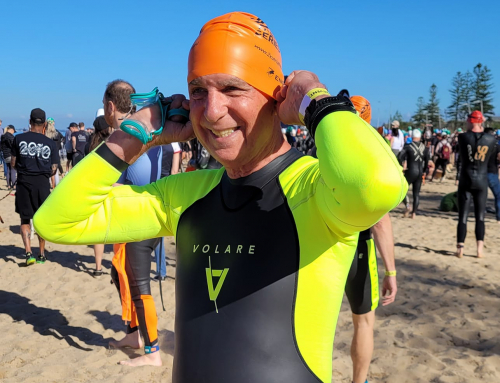Kicking is not important, you don’t need a super kick to have a great race in a triathlon. True, your kick is mainly for stability and body rotation but if you kick the wrong way, your kick becomes a very important part of your stroke as it will slow you down heaps and will put a block in the water as I like to call it J As you can see on the photo here, the leg extension area is large and is out of “the hip box” by quite a fair way. We call it scissor kicking…
SCISSOR KICKING:
With the water resistance and the bubble created by your body movements, it will have a large dragging effect each time you do this. It is often related to breathing pattern, a problem balancing in the water and weak core. We’re land mammals and it’s instinctive for us to move our legs and feet to keep our balance. We do the same thing in the water. Scissor kicks are a natural unconscious reaction to keep your balance in the water, most of the time swimmers don’t even know they’re doing it.
People who will do this, do not feel that comfortable in the water, cannot activate their core muscle and need that extra balance from their open kick to stay on top of the water to breathe easier. Most triathletes don’t have effective kick technique. Making your kick more effective will reduce the effort required to swim and boost your speed by reducing your drag.
A scissor kick hurts your swim times because of the enormous amount of drag they generate – it’s a bit like opening up a parachute behind you.
YOUR KICK SHOULD:
So, you need to work on your kick technique. There’s more to kicking that propulsion, you need an ‘effective’ kick.
- Your kick should lift your legs up to give you a good body position.
- Your kick should be low drag.
- Your kick timing should drive your rotation, not hinder it.
- Your kick should be low effort so it minimises energy use.
ASK YOURSELF THESE QUESTIONS:
- Can you point your toes but not straighten out your feet?
- When you kick on your back, do you tend to:
- Go very slow
- Stay in one place
- Sink in the water
- Do you have a tough time with swimming drills
- Is your kick is not propelling you forward fast enough
- Do you wear fins in workouts just to “keep up”?
- Did you start out as a runner and pick up swimming later to become a Triathlete?
If you answered “yes” to any of the above, you have runner’s or scissor kick! Even the worst of kickers can develop an adequate kick for freestyle. Here are some remedies:
1. Vertical Kicking
This drill has been around for a long time. Find water that is deep enough for you to kick in place. Let go of the wall, cross your arms or put them along your body, and kick in place in a vertical position (keep in a straight line), pointing your toes and keeping your chin above the surface of the water. Get your power from your quads and hips on this drill. Try 20 seconds at a time.
2. Use Fins But not to “keep up” in workouts.
If you have ankle flexibility issues, use fins, but wean off them as you get closer to your event. The shorter kind are best. Fins can increase your ankle flexibility, allow you to do swimming drills with ease, and strengthen the right leg muscles you need to kick.
3. Kick from your hips.
With good kicking technique, you can bend your knee a little on the down stroke but this shouldn’t be a ‘driven’ movement, it’s just a slight movement from a relaxed knee. As described in the tips below its best not to think about bending your knee at all, instead think about kicking from the hip with a straight leg – a very slight knee bend will happen naturally.
4. Just Stretch.
Sit with your feet underneath your body and toes pointed. Put your weight onto your feet. Hold for about 20-30 seconds, repeat few times through.
5. Point toes out.
Plantar flexion is technical jargon for pointing your toes. When you swim you should always have your toes pointed, this presents a much lower profile to the water. Not pointing your toes will push water forwards when you kick, slowing you dramatically.
6. Kick in 2 beat.
You kick twice for every cycle (a cycle is 2 arms strokes counting both arms). This is a slow kick speed that many distance swimmers and skilled triathletes use.
You don’t need to use a kick board to improve your kick. For distance swimming and triathlons, you are wasting your time with this floatation device!
Have patience, stick with these drills, and you will lose your runners or scissor kick before you know it!









